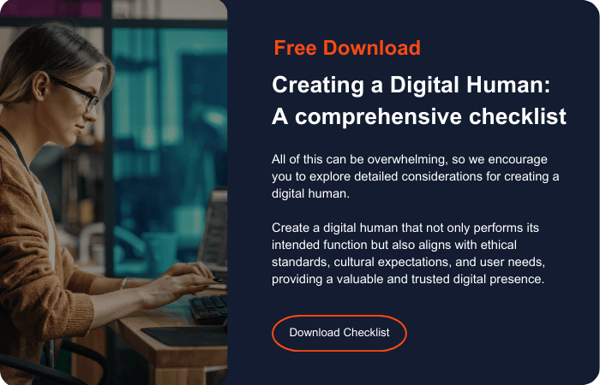
Creating a digital human involves a blend of technological sophistication, cultural understanding, and ethical responsibility.
Digital human technology, powered by artificial intelligence, is revolutionising industries by creating lifelike avatars for construction, healthcare, training and development, social media and much more.
This guide consolidates the key factors to consider, ensuring an effective and engaging digital human that aligns with diverse user needs.
1. Defining purpose and audience in creating digital humans
- Purpose Identification: Determine the digital human's role, be it for L&D training, product marketing, a digital assistant, or multilingual education, the intended role will drive many design and functional decisions.
- Audience Analysis: Create the immersive experience based on a thorough understanding of the target demographic's needs and expectations, this data informs the customisation of the digital human to ensure it resonates with users.
Digital human creation is crucial in designing interactions and user experiences. It involves defining interactions, scripting responses, and designing conversation flows to create a positive user experience while considering brand identity, target audience, and tone of the digital human.
2. Appearance and design considerations
- Visual Attributes: Choose the gender, age, ethnicity, and clothing that resonate with your audience and purpose. Understand who and what inspires your audience. This might include thoughtful choices about the digital human's age, gender presentation, ethnicity, and even style of dress.
- Cultural Sensitivity: Ensure the design is inclusive and reflects a commitment to diversity and cultural awareness. Research and test with sample audiences to guarantee the digital avatar resonates perfectly with your audience.
Incorporating facial expressions and motion capture technology is essential for creating lifelike and realistic digital humans. These technologies help in mimicking human actions, emotions, and interactions, creating a personalised and immersive digital presence.
3. Language and communication
- Accent Selection: Decide between a natural accent and localised accents to effectively communicate with specific regions or demographics.
- Language Proficiency: Identify the languages your digital human will speak, prioritising the primary languages of your audience and the feasibility of multilingual support.
Machine learning can enhance language proficiency and accent selection by analysing and replicating natural speech patterns, ensuring more realistic and accurate communication.
4. Voice cloning in digital human technology
- Legal and Ethical Use: When cloning the voice of a person to accompany their digital human, ensure that the software used complies with legal and ethical standards for the use of AI.
Find out more about defining safe and ethical principles for Digital Humans.
The concept of a virtual human extends to digital avatars that represent human beings in online platforms and virtual environments, mimicking human behaviours and emotions for various applications such as entertainment, education, and customer service.
A digital human, often called an ‘avatar’, ‘AI avatar’, or ‘digital avatar’, refers to digital representations of human beings used in various virtual and entertainment contexts, as well as in conversational AI.
- Protecting Privacy and Data: Ironclad controls must be in place to protect avatars and cloned voices. Ensure information security controls are certified compliant with ISO:27001 and independently verified.
- Transparency and Accountability: Maintain a transparent approach to development and use, will complete audit trails to evidence and track accountability for the digital human's interactions.
5. Modes of interaction
- Pre-Recorded Responses: For scripted interactions with predetermined responses.
- Real-Time Interactivity: To engage users dynamically based on their input.
- Virtual Reality Integration: For creating immersive, 3D-modelled experiences.
Creating realistic digital humans and realistic human avatars is key for enhancing immersive interactions in training, health and safety, retail and other digital domains.
6. Environmental context
- Setting and Background: Design environments that complement the digital human's interactions and enhance the user experience.
7. Enhancing realism in realistic digital humans
- Animation and Gestures: Employ realistic animations and gestures to humanise the digital avatar. The digital human should exhibit non-verbal cues that are culturally appropriate and enhance communication.
The use of virtual humans in various applications, such as video creation, customer service, education, and entertainment, enhances realism through lifelike behaviours and interactions.
8. Ensuring accessibility
- Accessibility Features: Include text-to-speech, voice commands, and subtitles to accommodate users with disabilities or language barriers.
9. Emotional and social intelligence
- Emotional Intelligence: Equip the digital human with the ability to display and perceive emotions, fostering empathetic interactions.
- Emotional Recognition: Integrate technology capable of recognizing user emotions to facilitate natural responses.
10. Privacy and security
- User Data Protection: Comply with data protection regulations and safeguard user privacy and data throughout interactions. Guildhawk protects client data with our Avatar SafeHouse™.
- Technical and Legal Compliance: Address technical requirements for functionality and scalability, while ensuring compliance with legal frameworks.
11. Testing and user feedback
- Usability Testing: Perform extensive testing across devices and platforms to identify usability issues.
- Iterative Improvement: Refine the digital human based on performance metrics and user feedback.
12. Long-term viability
- Maintenance Strategy: Plan for ongoing maintenance and updates to keep the digital human relevant and effective.
- System Integration: Facilitate seamless integration with existing systems for a unified user experience.
By adhering to these comprehensive guidelines, creators can develop a digital human that not only meets today's technological demands but also addresses the nuanced expectations of users in a globally connected world.
The ultimate goal is to create a digital human that is not just a technological marvel but a responsible, culturally attuned, and user-friendly presence in the digital world.


